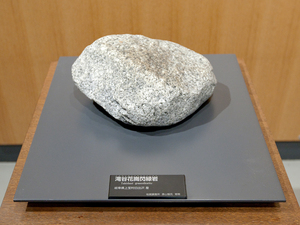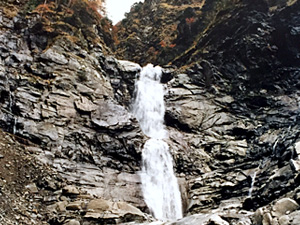Nagoya City Science Museum
TOP > Exhibition Guide > Floor Map> The youngest exposed granite
The youngest exposed granite



Purpose of Exhibition
The rock exhibited here shows how rapid the "Japan Alps" elevated. The youngest exposed granite displayed shows that the history of the Earth is recorded in ordinary, every day rocks.
Additional Knowledge
[The Takidani Granodiorite has been growing vertically 6000 meters for 1.2 million years]
The rock known as "Takidani Granodiorite", which covers an area extending from Kamikochi in the Nagano Prefecture to Okuhida in the Gifu Prefecture in the Northern Alps of Japan, is one of the world's youngest exposed granites. "Takidani" is the name of the place of origin and "Granodiorite" is a type of plutonic rock formed by the solidification of magma deep underground. A paper published in 1992 reports that the age of the rock is approximately 1.2 million years old, making it the world's youngest exposed granite.
You may wonder what is so fantastic about the rock being termed "young" rather than "old" or you may think it strange that a rock formed 1.2 million years ago can be labeled "young." In fact, granite from several million years ago is uncommon. The majority of granite found in the Aichi Prefecture solidified approximately 70 to 100 million years ago.
A gigantic caldera volcano was active in this area about 2 million years ago. A magma chamber beneath the volcano gradually solidified for approximately 800 thousand years, finally solidifying completely about 1.2 million years ago, to form the "Takidani Granodiorite".
The solidified magma began to elevate about 1.2 million years ago and is now exposed. This means that the elevation was rapid. We assume that the upper surface of the solidified magma (Takidani Granodiorite) was located at a depth of 3000m underground. Today, it is located at an elevation of almost 3000m. This suggests that it elevated almost 6000m in about 1.2 million years. A simple calculation shows that the rate of the elevation is approximately 5mm a year.
[The Kurobegawa Granite elevated 5000m in 800 Thousand Years]
The youngest granite record was broken in 2013 when it was discovered that the "Kurobegawa Granite", exposed near the Sennindani Dam to the north of the Kurobe Dam, dated back approximately 800 thousand years. Since the site of exposure is at an elevation of around 2000m and if the granite uplifted from a depth of 3000m underground, a simple calculation shows that the rate of elevation was 6.25mm a year; this is even faster than the rate of the Takidani Granodiorite.
Thus, the Northern Alps of Japan, extending from Hotaka to Kurobe, has been rising several millimeters a year. This shows a drastic change in Earth history. Although the cause of this phenomenon is not well known, it is believed that it is related to compressive stress caused by plate movement since it cannot be explained simply by the buoyancy of magma. Young granitic rocks suggest remarkable activity of the islands of Japan.
As you can see, these granitic rocks are not unusual and look like the kind of rock you see anywhere. Scientists read such records in rocks to reveal the history of the earth.
Article by Shoji Nishimoto, curator
